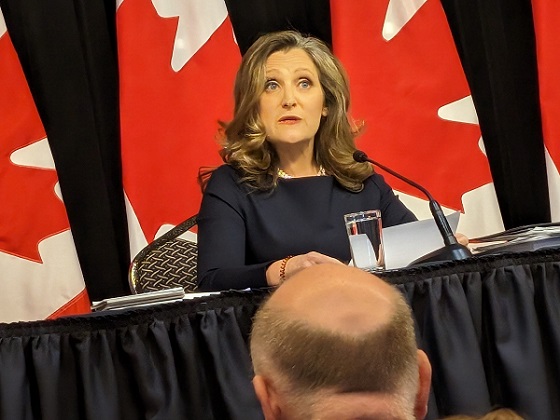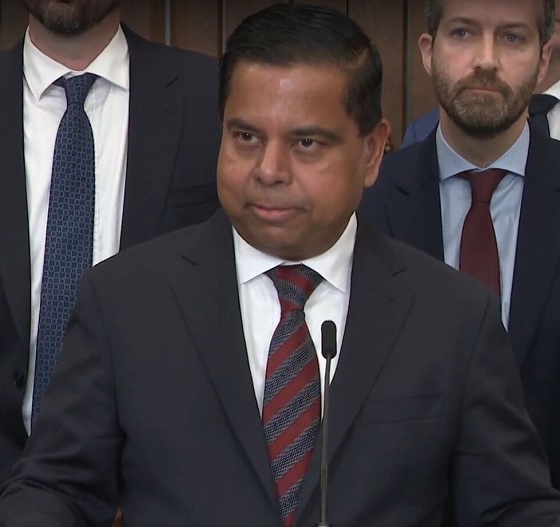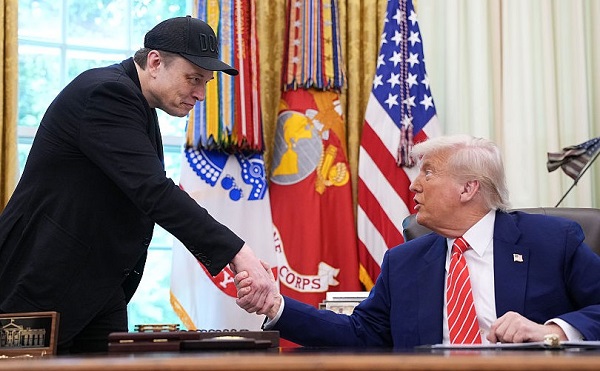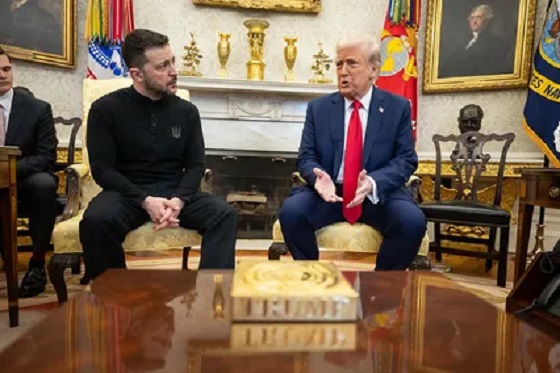National
Paul Wells: Perhaps Freeland isn’t the victim here. Perhaps it’s Freeland who set Trudeau up

The minister of everything
Did Trudeau just blink?
And now we interrupt my own previously-quiet Sunday night for some rampant speculation. There is a lot going on. I am left to generate hypotheses that might explain some of it.
On Sunday night we watched the last two episodes of The Madness on Netflix (stylish but not entirely persuasive), then it came time to check the headlines, as one does in Ottawa after Netflix.
Holy frijoles: Sean Fraser is said to be leaving the federal cabinet and, when the time comes, federal politics altogether. This is surprising but plausible: the 338Canada projection (which, always remember, is not based on local polling, it’s just an extrapolation, but still) has him 17 points behind the Conservatives in his Central Nova riding, he’s got young children, and one wiseacre wrote 14 months ago that we should expect talent to leave this government:
|
But that wasn’t even nearly the night’s biggest big-if-true story: John Ivison is reporting from his tropical outpost that Chrystia Freeland’s getting ready to deliver a fiscal update without the profligate, unworkable free-cheque plan. That’s the $250 “working Canadians rebate” described in this backgrounder, which I should now maybe screenshoot because who knows whether it’ll be there in the morning.
Instead I screenshot Chris Selley on X, who is reliably entertaining:
But here’s where the speculation begins. I’m not sure “they” tried and failed. I think there’s another hypothesis that fits the available data.
The double-reverse Morneau?
It’s been less than a week since the Globe published an article on “tensions” between the PMO and Freeland’s office over “GST holiday, $250 cheques.” The piece, by Globe Ottawa bureau chief Bob Fife and reporter Marieke Walsh, quoted many unnamed sources to the effect that “tensions have risen between Ms. Freeland’s office and the PMO over spending.”
You might say all of this appears to be similar to what happened with Ms. Freeland’s predecessor, Bill Morneau, before he departed the government in 2020. If so, you must be one senior Liberal, because Fife and Walsh quote “one senior Liberal” who says the current situation “appears to be similar to what happened with Ms. Freeland’s predecessor, Bill Morneau, before he departed the government in 2020.”
And indeed, the story was strongly reminiscent of the extraordinary moment, which I can still hardly believe, when a bored Prime Minister had his lackeys organize a leak campaign against his own finance minister during a global fiscal calamity in 2020. Then as now, reporters were breathlessly informed that Trudeau had, at some point, even managed to get The Great Mark Carney on the phone, as if that could justify anything.
(Indeed, one of the underappreciated aspects of Trudeau’s 2020 ejection of Morneau was the way Carney wandered through the story, entirely oblivious, before simply vanishing.)
So Tuesday’s Fife/Walsh story triggered much outrage in Ottawa circles. How dare the PMO set up another finance minister? And a woman at that, even as Trudeau himself was parading as a champion of feminism?
But if Ivison is correct that the cheques will be gone from Monday’s fall update, that leaves open a very different possibility.
Perhaps Freeland isn’t the victim here. Perhaps it’s Freeland who set Trudeau up.
Subscribe to Paul Wells at $5 a month or $50 a year, and lock in that rate before I hike it in the New Year.
Indeed, the quotes nearest the top of Fife and Walsh’s story suggest that at least some of their sources are not mere PMO conduits, but rather people who have spent some time energetically rolling their eyes at the PM’s behaviour. “The sources say the idea for a sales-tax break… was driven by the Prime Minister’s Office (PMO), as was the pledge to send $250 benefit cheques,” the reporters write. “The Finance Department viewed the $6.28-billion plan as fiscally unwise, with one source saying Finance officials described the GST holiday as making little economic sense.”
The Globe story does point out that the NDP supports the (also profligate, also unworkable) point-of-sale GST “holiday) but not the $250 cheques, because the NDP, like the Bloc, wants the cheques to go to more people, including seniors. My revered colleague Occam of Razor would say that’s the only explanation anyone needs for the apparent climbdown on the cheques: it’s only prudent to take everything out of a fiscal plan that might lead to a minority government’s defeat in the Commons.
But the tone of Tuesday’s Globe story, the moment of its appearance, and the apparent result — the wreck of the cheque plan — suggest this may be a case of something everyone in Ottawa has seen many times during the Trudeau government: a tactical decision to take a private dispute public, because if there’s one thing that can get this PMO’s attention, it’s an embarrassing headline.
Again, I need to emphasize: I don’t know Fife and Walsh’s sources or their motives. I have found that speculation about a reporter’s anonymous sources is usually just bad guesswork. And the repeated mentions in the Globe story of its “ten sources” suggests the reporters pieced together their account from several sources, that they weren’t passive conduits for anyone.
But as I’ve written a few times in the past, many organizations that deal with this government learned along ago that it is pointless to hope that their concerns will be addressed through routine channels. Instead, you have a much better chance of getting satisfaction by escalating your file out of a dusty cabinet and onto the front page of the Globe and Mail. As I wrote here more than two years ago:
“Everybody knows that if the government of Canada is doing something they don’t like, they should tell a reporter about it, because the government of Canada will instantly reverse course to make the bad headline stop hurting. Issues management squads have the only autonomy in this government. They react to headlines as Dracula did to garlic. This realization is now baked into the procedural book of everyone who deals with this government in any capacity — and, plainly, of increasing numbers of people who work inside it.”
Imagine reading Tuesday’s Globe story if you work in the PMO and you’re not actively scheming to get Chrystia Freeland out of the government. The story would be full of surprises for you: (1) the cheque plan is despised by the Finance Department; (2) somebody is mighty eager to make sure everyone knows it was your idea; (3) somebody is talking about the government losing its finance minister. If you don’t have Carney lined up to take the job, the prospect of a looming vacancy starts to look more like a threat than an opportunity.
Buy someone a gift subscription
I first met Chrystia Freeland in 1999, when she began a brief stint as deputy editor of the Globe and Mail. (Fife was then working for the Globe’s crosstown rivals at the National Post, as was I.) To say the least, I’ve seen little in recent years that suggests Freeland is a superb communications tactician. But brushing a stunned or recalcitrant PMO back by escalating a story onto the Globe’s front page doesn’t take a deft touch, either. These days, it seems just about everyone can do it.
Anyway, that’s my speculation. Here’s what we know, or will if these stories are confirmed on Monday: Trudeau has formidable resources available to keep himself in his cabinet, but he has no particular such influence over his ministers. All of whom are now being reminded of their autonomy by the example of Fraser. And a multi-billion-dollar scheme that seemed, only days ago, to be the point of the fall update now seems unlikely to be implemented.
Invite your friends and earn rewards
Alberta
Punishing Alberta Oil Production: The Divisive Effect of Policies For Carney’s “Decarbonized Oil”

From Energy Now
By Ron Wallace
The federal government has doubled down on its commitment to “responsibly produced oil and gas”. These terms are apparently carefully crafted to maintain federal policies for Net Zero. These policies include a Canadian emissions cap, tanker bans and a clean electricity mandate.
Following meetings in Saskatoon in early June between Prime Minister Mark Carney and Canadian provincial and territorial leaders, the federal government expressed renewed interest in the completion of new oil pipelines to reduce reliance on oil exports to the USA while providing better access to foreign markets. However Carney, while suggesting that there is “real potential” for such projects nonetheless qualified that support as being limited to projects that would “decarbonize” Canadian oil, apparently those that would employ carbon capture technologies. While the meeting did not result in a final list of potential projects, Alberta Premier Danielle Smith said that this approach would constitute a “grand bargain” whereby new pipelines to increase oil exports could help fund decarbonization efforts. But is that true and what are the implications for the Albertan and Canadian economies?
The federal government has doubled down on its commitment to “responsibly produced oil and gas”. These terms are apparently carefully crafted to maintain federal policies for Net Zero. These policies include a Canadian emissions cap, tanker bans and a clean electricity mandate. Many would consider that Canadians, especially Albertans, should be wary of these largely undefined announcements in which Ottawa proposes solely to determine projects that are “in the national interest.”
The federal government has tabled legislation designed to address these challenges with Bill C-5: An Act to enact the Free Trade and Labour Mobility Act and the Building Canada Act (the One Canadian Economy Act). Rather than replacing controversial, and challenged, legislation like the Impact Assessment Act, the Carney government proposes to add more legislation designed to accelerate and streamline regulatory approvals for energy and infrastructure projects. However, only those projects that Ottawa designates as being in the national interest would be approved. While clearer, shorter regulatory timelines and the restoration of the Major Projects Office are also proposed, Bill C-5 is to be superimposed over a crippling regulatory base.
It remains to be seen if this attempt will restore a much-diminished Canadian Can-Do spirit for economic development by encouraging much-needed, indeed essential interprovincial teamwork across shared jurisdictions. While the Act’s proposed single approval process could provide for expedited review timelines, a complex web of regulatory processes will remain in place requiring much enhanced interagency and interprovincial coordination. Given Canada’s much-diminished record for regulatory and policy clarity will this legislation be enough to persuade the corporate and international capital community to consider Canada as a prime investment destination?
As with all complex matters the devil always lurks in the details. Notably, these federal initiatives arrive at a time when the Carney government is facing ever-more pressing geopolitical, energy security and economic concerns. The Organization for Economic Co-operation and Development predicts that Canada’s economy will grow by a dismal one per cent in 2025 and 1.1 per cent in 2026 – this at a time when the global economy is predicted to grow by 2.9 per cent.
It should come as no surprise that Carney’s recent musing about the “real potential” for decarbonized oil pipelines have sparked debate. The undefined term “decarbonized”, is clearly aimed directly at western Canadian oil production as part of Ottawa’s broader strategy to achieve national emissions commitments using costly carbon capture and storage (CCS) projects whose economic viability at scale has been questioned. What might this mean for western Canadian oil producers?
The Alberta Oil sands presently account for about 58% of Canada’s total oil output. Data from December 2023 show Alberta producing a record 4.53 million barrels per day (MMb/d) as major oil export pipelines including Trans Mountain, Keystone and the Enbridge Mainline operate at high levels of capacity. Meanwhile, in 2023 eastern Canada imported on average about 490,000 barrels of crude oil per day (bpd) at a cost estimated at CAD $19.5 billion. These seaborne shipments to major refineries (like New Brunswick’s Irving Refinery in Saint John) rely on imported oil by tanker with crude oil deliveries to New Brunswick averaging around 263,000 barrels per day. In 2023 the estimated total cost to Canada for imported crude oil was $19.5 billion with oil imports arriving from the United States (72.4%), Nigeria (12.9%), and Saudi Arabia (10.7%). Since 1988, marine terminals along the St. Lawrence have seen imports of foreign oil valued at more than $228 billion while the Irving Oil refinery imported $136 billion from 1988 to 2020.
What are the policy and cost implication of Carney’s call for the “decarbonization” of western Canadian produced, oil? It implies that western Canadian “decarbonized” oil would have to be produced and transported to competitive world markets under a material regulatory and financial burden. Meanwhile, eastern Canadian refiners would be allowed to import oil from the USA and offshore jurisdictions free from any comparable regulatory burdens. This policy would penalize, and makes less competitive, Canadian producers while rewarding offshore sources. A federal regulatory requirement to decarbonize western Canadian crude oil production without imposing similar restrictions on imported oil would render the One Canadian Economy Act moot and create two market realities in Canada – one that favours imports and that discourages, or at very least threatens the competitiveness of, Canadian oil export production.
Ron Wallace is a former Member of the National Energy Board.
Fraser Institute
Long waits for health care hit Canadians in their pocketbooks

From the Fraser Institute
Canadians continue to endure long wait times for health care. And while waiting for care can obviously be detrimental to your health and wellbeing, it can also hurt your pocketbook.
In 2024, the latest year of available data, the median wait—from referral by a family doctor to treatment by a specialist—was 30 weeks (including 15 weeks waiting for treatment after seeing a specialist). And last year, an estimated 1.5 million Canadians were waiting for care.
It’s no wonder Canadians are frustrated with the current state of health care.
Again, long waits for care adversely impact patients in many different ways including physical pain, psychological distress and worsened treatment outcomes as lengthy waits can make the treatment of some problems more difficult. There’s also a less-talked about consequence—the impact of health-care waits on the ability of patients to participate in day-to-day life, work and earn a living.
According to a recent study published by the Fraser Institute, wait times for non-emergency surgery cost Canadian patients $5.2 billion in lost wages in 2024. That’s about $3,300 for each of the 1.5 million patients waiting for care. Crucially, this estimate only considers time at work. After also accounting for free time outside of work, the cost increases to $15.9 billion or more than $10,200 per person.
Of course, some advocates of the health-care status quo argue that long waits for care remain a necessary trade-off to ensure all Canadians receive universal health-care coverage. But the experience of many high-income countries with universal health care shows the opposite.
Despite Canada ranking among the highest spenders (4th of 31 countries) on health care (as a percentage of its economy) among other developed countries with universal health care, we consistently rank among the bottom for the number of doctors, hospital beds, MRIs and CT scanners. Canada also has one of the worst records on access to timely health care.
So what do these other countries do differently than Canada? In short, they embrace the private sector as a partner in providing universal care.
Australia, for instance, spends less on health care (again, as a percentage of its economy) than Canada, yet the percentage of patients in Australia (33.1 per cent) who report waiting more than two months for non-emergency surgery was much higher in Canada (58.3 per cent). Unlike in Canada, Australian patients can choose to receive non-emergency surgery in either a private or public hospital. In 2021/22, 58.6 per cent of non-emergency surgeries in Australia were performed in private hospitals.
But we don’t need to look abroad for evidence that the private sector can help reduce wait times by delivering publicly-funded care. From 2010 to 2014, the Saskatchewan government, among other policies, contracted out publicly-funded surgeries to private clinics and lowered the province’s median wait time from one of the longest in the country (26.5 weeks in 2010) to one of the shortest (14.2 weeks in 2014). The initiative also reduced the average cost of procedures by 26 per cent.
Canadians are waiting longer than ever for health care, and the economic costs of these waits have never been higher. Until policymakers have the courage to enact genuine reform, based in part on more successful universal health-care systems, this status quo will continue to cost Canadian patients.
-

 International12 hours ago
International12 hours agoIsrael’s Decapitation Strike on Iran Reverberates Across Global Flashpoints
-

 Business1 day ago
Business1 day agoThe carbon tax’s last stand – and what comes after
-

 Business22 hours ago
Business22 hours agoTrump: ‘Changes are coming’ to aggressive immigration policy after business complaints
-

 International1 day ago
International1 day agoPentagon agency to simulate lockdowns, mass vaccinations, public compliance messaging
-

 Business2 days ago
Business2 days agoJustice Centre launches new petition: Keep cash legal and accessible. Stop Bill C-2
-

 illegal immigration21 hours ago
illegal immigration21 hours agoLA protests continue as judge pulls back CA National Guard ahead of ‘No Kings Day’
-

 International2 days ago
International2 days agoElon Musk expresses ‘regret’ over attacks on Trump that ‘went too far’
-

 National1 day ago
National1 day agoCarney promotes MP instrumental in freezing Freedom Convoy donors’ bank accounts










